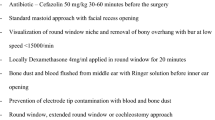Abstract
Preservation of residual hearing should be a desirable outcome of implant surgery. Prevention of neural degeneration due to loss of residual hair cells, together with the continuous progress in cochlear implant technology should be able to preserve cochlear integrity as well as possible. The degree of hearing preservation may vary depending on surgical approach, maximum insertion depth and other factors not uniformly considered to date. The aim of this retrospective case controlled study is to evaluate residual hearing after cochlear implant surgery. In particular, we analyzed data obtained with use of two different kinds of electrode arrays, with and without rigid introductor (stylet). We report the results on 37 patients with measurable preoperative hearing thresholds, mean age of 28 years (5–70 years), having the following implants: seven Advanced Bionics®, four Med-El®, 24 Cochlear®, two MXM®; 19 of them were performed using the stylet and the other 18 without it. A minimally invasive surgical approach was performed with a short retroauricular incision and a 1.2 mm cochleostomy. A complete electrode array insertion was obtained in all patients. Responses to pure-tone stimuli were measured for each ear in pre-implantation conditions and 3–12 months after surgery. After implantation 14 patients (38%) showed no hearing threshold variation, 29 (78%) maintained an appreciable hearing threshold level in the implanted ear, 8 (22%) had a total loss of residual hearing. Median increases of threshold levels were, in all 37 studied patients, 5, 10, 10 and 5 dB HL, respectively, for 125, 250, 500 and 1 kHz. For the 18 patients having implants without the stylet median increases of threshold levels were 0, 10, 5 and 7 dB HL; in the stylet group, they were 10, 5, 5 and 10 dB HL. On a comparison between the stylet and the non-stylet group, no significant differences in mean hearing threshold worsening were found. Data seem to suggest that cochlear function is less sensitive to mechanical trauma during implant surgery than was thought. Besides, electrode array stiffness seems not to influence preservation of cochlear residual functional integrity. Finally, the authors hypothesize a direct spiral ganglion activation under strong mechanical stimulation.




Similar content being viewed by others
References
Kiefer J, Gstoettner W, Baumgartner W, Pok SM, Tillein J, Ye Q, Ilberg C (2004) Conservation of low frequency hearing in cochlear implantation. Acta Otolaryngol 124:272–280
Brimacombe JA, Arndt PL, Staller SJ, Beiter AL (1994) Multichannel cochlear implantation in adults with severe-to-profound sensorineural hearing loss. In: Hochmair Desoyer IJ, Hochmair E (eds) Advances in cochlear implants. Manz, Vienna, pp 387–392
Rizer FM (1988) Post operative audiometric evaluation of cochlear implant patients. J Otolaryngol 98:203–206
Kiefer J, von Olphen AF, Langereis M, Mens L, Broks J, Smoorenburg G (1999) Predictors of cochlear implant performance. Audiology 38:109–116
Hodges AV, Schloffman J, Balkany T (1997) Conservation of residual hearing with cochlear implantation. Am J Otol 18:179–183
Dye L, House WF, O’Connor C (1987) Measurable residual hearing following cochlear implantation. Paper presented at the annual meeting of the American Academy of Otolaryngology/Head and Neck Surgery, Chicago
Skarzynski H, Lorens A, D’Haese P, et al (2002) Preservation of residual hearing in children and post-lingually deafened adults after cochlear implantation: an initial study. ORL J Otorhinolaryngol Relat Spec 64:247–253
James C, Albegger K, Battmer R, Burdo S, Deggouj N, Deguine O, et al (2005) Preservation of residual hearing with cochlear implantation: how and why. Acta Otolaryngol 125:481–491
Webb RL, Clark GM, Shepherd RK, et al (1988) The biological safety of cochlear corporation multi-electrode intracochlear implant. Am J Otol 9:8–13
Clark GM, Shepherd RK, Dowell RC (1988) Histopathology following cochlear implantation in a patient. Acta Otolaryngol Suppl (Stockh)106:448
Blakany TJ, Hodges AV, Whitehead M, Meamary F (1994) Cochlear endoscopy with preservation of hearing in guinea pigs. Otolaryngol Head Neck Surg 111:439–445
Lehnhardt E (1993) Intracochlear placement of cochlear implant electrodes in soft surgery technique. HNO 41:356–359
Lehnhardt E, Laszig R (1994) Specific surgical aspects of cochlear implant soft surgery. In: Hochmair-Desoyer IJ, Hochmair ES (eds) Advances in cochlear implants. Manz, Vienna, pp 228–229
Cohen NL (1997) Cochlear implant soft surgery: fact or fantasy? Otolaryngol Head Neck Surg 117:214–216
Gstottner W, Kiefer J, Baumgartner WD, Pok S, Peters S, Adunka O (2004) Hearing preservation in cochlear implantation for electro acoustic stimulation. Acta Otolaryngol 124:348–352
House HP, Hansen MR, Al Dakhail AAA, House JW (2002) Stapedectomy versus stapedotomy: comparison of results with long-term follow-up. Laryngoscope 112:2046–2050
Balkany TJ, Hodges AV, Gomez-Marin O, Bird PA, et al (1999) Cochlear reimplantation. Laryngoscope 109:351–355
Khan AM, Handzel O, Damian D, Eddington DK, Nadol JB (2005) Effect of cochlear implantation on residual spiral ganglion cell count as determined by comparision with the contralateral nonimplanted inner ear in humans. Ann Otol Rhinol Laryngol 114: 381–385
Author information
Authors and Affiliations
Corresponding author
Rights and permissions
About this article
Cite this article
Di Nardo, W., Cantore, I., Melillo, P. et al. Residual hearing in cochlear implant patients. Eur Arch Otorhinolaryngol 264, 855–860 (2007). https://doi.org/10.1007/s00405-007-0270-8
Received:
Accepted:
Published:
Issue Date:
DOI: https://doi.org/10.1007/s00405-007-0270-8




